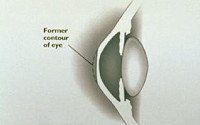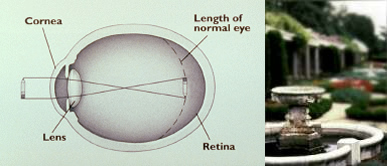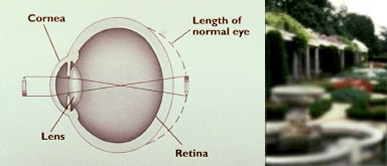Laser Vision Correction
Overview
Laser Vision Correction by Dr. Bryan Brooks
Lasik and PRK are offered at Richmond Eye Associates by Dr. Bryan Brooks. He is fully trained to use the latest technology available to give you freedom from glasses or contact lenses. Using state-of-the-art laser technology, which includes CustomVue™ Lasik to improve vision, many patients may see better than they ever could before surgery, even with their glasses or contact lenses.
Dr. Brooks offers complimentary eye examinations to evaluate whether or not you may be a candidate for Laser Vision Correction. If you are interested in having Laser Vision Correction to free yourself from dependence on glasses or contact lenses, call (804) 270-0330 for an evaluation.
Complimentary Screening Consultations
A Laser Vision Correction Screening is not a comprehensive eye examination, but rather a brief examination and discussion to determine if you are a possible candidate for Laser Vision Correction.
Laser Vision Correction Screenings are complimentary (no charge). If you have glasses, please bring them to the screening. If you normally wear contact lenses, please wear them to the screening. Please call (804) 270-0330 to schedule a complimentary Laser Vision Correction Screening Consultation with Dr. Bryan Brooks.
Customized Lasik Using CustomVue™
What is CustomVue™ LASIK?
CustomVue™ WaveFront guided LASIK is the latest advance in LASIK technology from VISX, the leader in excimer laser technology.
Each of us has unique vision characteristics, just like each of us has a unique fingerprint. To treat each patient individually we obtain a WavePrint examination of each eye, and then use the detailed unique information of the WavePrint to plan the laser treatment down to the micron level (about one millionth of a meter)
In Clinical Trials CustomVue™ treatment resulted in 98% of patients 20/20 or better and 70% 20/16 or better, and 23% 20/12 or better.
How does CustomVue™ LASIK work?
The CustomVue™ system first uses an infrared laser to intricately measure the entire optical system of each eye and record the minute irregularities (higher order aberrations) of the optical system, in effect creating a fingerprint of each eye. The doctor then reviews the WavePrint measurements and instructs the computer to calculate the best treatment for each individual eye.
The laser surgery itself is performed using the VISX S4 Variable Spot Scanning technique with 3-dimensional eye tracking to sculpt the cornea into the ideal shape. This is an improvement over standard LASIK, which treats based on the measurement of the corrective lens prescription, and does not use the fingerprint of the eye to customize the treatment.
When do I see the Results?
Many patients wake up the next day with reasonably sharp, clear vision, which continues to improve over several days. Some patients, while noting improvement, may have to wait longer.
Are there risks with CustomVue™?
All surgery has risks as well as benefits. These will be reviewed at the time of your consultation.
What about night glare and halos?
Most patients report less night vision problems after CustomVue™ LASIK than before the surgery.
How does CustomVue™ differ from regular LASIK?
Regular LASIK treats each patient based upon a prescription for glasses, CustomVue™ uses the individual WavePrint of each eye. The VISX Star S4 laser with its unique Variable Spot Scanning technology can precisely treat very small areas, to sculpt the cornea into the ideal shape for your eye.
Does CustomVue™ take longer?
The laser treatment is about the same, usually less than a minute, the whole operation usually lasts less than fifteen minutes! CustomVue™ does require extra time to obtain the most accurate WavePrint of your eyes. The thorough preoperative medical eye exam still takes about 2 hours.
With conventional LASIK we get excellent vision results, allowing patients to see clearly without contact lenses or glasses. With CustomVue™ the results are even better, reducing night glare, reducing vision problems, and achieving in many patients, sharper vision than possible with glasses.
Reasons to Consider Lasik
Ten Reasons to Consider Laser Vision Correction
Lasik and PRK - About the Procedure
What is Laser Vision Correction?
Lasik and PRK the most common Laser Vision Correction procedures, and they are somewhat similar. Both use an excimer laser to painlessly reshape the front surface of the cornea to create the desired vision correction. The excimer laser is a non-thermal (cool) laser that is controlled by a computer. The actual time that the laser takes to do its work is usually less than one minute. Farsighted corrections and combinations of nearsightedness and astigmatism may take slightly longer.
In Lasik (Laser Assisted In-Situ Keratomileusis), the surgeon first creates a micro thin flap of the surface of the cornea using a sterile surgical instrument called a "microkeratome".

This flap is folded back, and the excimer laser is used to shape the cornea surface. The flap is then replaced and usually does not require suturing to stay in position. The vision typically returns rapidly after Lasik, and a bandage contact lens in not usually necessary because the eye is not usually painful after surgery. Thus, both eyes are often treated in the same session with Lasik. Lasik can be used to treat low to high levels of nearsightedness with low to moderate levels of astigmatism, and low to moderate farsightedness with low to moderate levels of astigmatism.
 In PRK (Photorefractive Keratectomy), the surgeon prepares the surface of the cornea, and then uses the excimer laser to precisely and rapidly reshape the surface of the cornea. The corneal surface must then heal, and often a bandage contact lens is used for comfort. The vision may be blurred in the operated eye for a couple of weeks after the procedure. The excimer laser is FDA approved for PRK for low to moderate levels of nearsightedness and astigmatism, and low levels of hyperopia and astigmatism.
In PRK (Photorefractive Keratectomy), the surgeon prepares the surface of the cornea, and then uses the excimer laser to precisely and rapidly reshape the surface of the cornea. The corneal surface must then heal, and often a bandage contact lens is used for comfort. The vision may be blurred in the operated eye for a couple of weeks after the procedure. The excimer laser is FDA approved for PRK for low to moderate levels of nearsightedness and astigmatism, and low levels of hyperopia and astigmatism.
What is Refractive Error?
Laser Vision Correction treats refractive errors of the eye. A refractive error is an incorrect focusing of an image onto the retina by the cornea and lens of the eye. The cornea, just by its curvature, does about 80% of the focusing of the eye. The lens within the eye does the remaining focusing.
Myopia

Example of a Myopic Eye and Image
In myopia (nearsightedness), the cornea is curved too steeply for the length of the eye, and the image is focused in front of the retina. This leads to blurred vision at distance, while the vision may be clear at a closer distance (thus "nearsighted").
Hyperopia

Example of a Hyperopic Eye and Image
In hyperopia (farsightedness), the cornea is not curved enough to focus light onto the retina, or the eye is too short in length. This leads to blurred vision at both near and distance, but the vision will be less blurred at distance (thus "farsighted"). If the lens of the eye is capable of focusing, some or all of a farsighted refractive error may be self-corrected by the eye by focusing in the image.
Astigmatism

Example of an Astigmatism Image
In astigmatism, the cornea is curved more in one direction than another. This leads to different parts of an image being in focus at different places on the retina. Astigmatism can occur in combination with myopia or hyperopia. In the example below, the vertical lines of the image are blurred more than the horizontal lines. The direction of blurring can occur at any angle from horizontal to vertical, which is the axis of astigmatism.
Presbyopia
In presbyopia (the inability to focus at near), the lens in the eye loses its near focusing ability, so reading glasses or bifocals are needed for close vision. Presbyopia can occur in combination with any other type of refractive error.
All of the above refractive errors can be corrected by glasses or contact lenses, or with bifocals or reading glasses in the case of presbyopia. Laser Vision Correction can correct from low to high levels of myopia with or without astigmatism, and low to moderate levels of hyperopia with or without astigmatism. Laser Vision Correction cannot restore the focusing ability of the lens of the eye, and thus presbyopia cannot by treated at this time. However, one eye can be left intentionally nearsighted for reading, similar to the monovision effect with contact lenses.
What Happens Before Laser Vision Correction?
The preoperative examination is an extremely important step in achieving an accurate result from PRK or Lasik. While a screening evaluation can determine potential candidates, it is the actual preoperative examination that determines which procedure, if any, are best for the patient. Some details of this examination include:
Financing arrangements should be made prior to the day of surgery, and any post-operative medications required should be obtained prior to surgery.
The Day of Surgery
Both Lasik and PRK are painless to perform, and require only eye drop (topical) anesthesia. In some cases, an oral sedative can be given preoperatively, but the patient must be alert enough to be able to keep the eye in position during the actual application of the laser. The eyelids themselves are held open with a smooth metal device called a speculum, so the patient does not have to worry about keeping his eyes open during the procedure. Usually street clothes can be worn for the procedure, although eye makeup and perfume or cologne should not be worn, as this can interfere with the laser function. There should be a person available to drive the patient home.
The Laser Vision Correction Procedures
Procedure Overview
In Lasik, a microkeratome is used to create a paper-thin flap on the surface of the cornea prior to the application of the laser. In PRK, the surgeon prepares the surface of the eye more superficially prior to the laser application. After the laser creates the desired refractive effect, the flap is placed back into position in Lasik, where it stays firmly in place without the need for sutures. In PRK, the surface of the eye must heal back over after the laser application, and usually a bandage contact lens is placed for comfort during the healing process, which may take one to three days. Both eyes can be treated in the same session with Lasik, while with PRK the eyes are usually treated a few weeks apart.
The laser used is a state-of-the-art VISX Star S4 ActiveTrak Excimer Laser with the WaveScan WaveFront System . This system features an active eye tracking technology in all 3 dimensions (horizontal, vertical, and up and down motion of the eye), Variable Spot Scanning technology, and an 8.0 mm Blend Zone option. These features all help to give the smoothest possible laser application. Plus, unlike some lasers, dilation is not required for laser eye tracking during the procedure!
Procedure: Lasik
Procedure: PRK
After Laser Vision Correction
After Lasik: It is important not to rub the eye after the procedure. Postoperatively, antibiotic eye drops are used as well as lubricating artificial tears. Pain medication is usually not necessary, and the vision will clear within hours or days. The first follow-up visit is usually the next day.
After PRK: The operated eye is checked frequently until the cornea heals underneath the bandage lens, which can take from four to seven days. The bandage lens is then removed. The vision is usually somewhat blurred after PRK for days to weeks.
After Laser Vision Correction, follow-up visits are scheduled at regular intervals to insure that the cornea is healing properly. Usually patients are seen the first day after the procedure, followed by one week, two to four weeks, and then two to three months. More follow-up visits are initially required after PRK due to the initial healing stage of the cornea and the use of a bandage contact lens. Except for artificial tears, eye drops are usually discontinued one to two weeks after Lasik. Prescription eye drops are used for a few months after PRK.
It is important to protect the eyes from sun exposure after Laser Vision Correction by using ultraviolet protecting sunglasses. The eyes may feel somewhat dry after Laser Vision Correction, and artificial tears should be used liberally. Most activities are safe to engage in after Laser Vision Correction, but swimming should be avoided for at least one week.
Clinical Results of Laser Vision Correction:
CRS Clinical Research coordinated a physician led and funded study to evaluate the safety and effectiveness of LASIK using the VISX excimer laser. This laser has been FDA approved for the LASIK procedure based on the data collected from the CRS studies.
The CRS study looked at the results of LASIK from a variety of surgeons using the VISX excimer laser. 723 eyes were treated initially by the VISX laser.
Further clinical studies have expanded the range FDA approved treatment for nearsightedness, astigmatism, and farsightedness by Lasik to what it is today. With the advent of CustomVue™ Lasik, visual acuity results after Lasik have continued to improve.
Complications of Laser Vision Correction:
All surgical procedures carry risk, although complications following Laser Vision Correction have generally been uncommon. A thorough discussion of the risks and complications of Laser Vision Correction can be found at Laser Vision Correction Risks & Complications.
Misconceptions about Lasik
Common Misconceptions about Laser Vision Correction
Being a Good Candidate
Characteristics of a Good Candidate for Laser Vision Correction
A good candidate for Laser Vision Correction should have a thorough discussion with the operating surgeon about the surgery itself and the goals of the surgery. Potential risks, side effects, and alternative treatments should be discussed. The prospective candidate for surgery should understand that while the results of Laser Vision Correction have been excellent, every individual eye may heal differently from another, sometimes with unexpected results. Thus, there may be a need for retreatment after an initial healing period. The patient should understand his motives for desiring Laser Vision Correction, and have realistic expectations about the outcome of the procedure.
There may be certain medical or ocular reasons that may prevent a person from safely having Laser Vision Correction:

